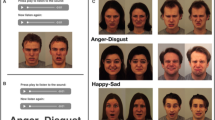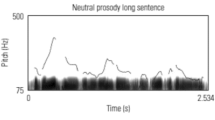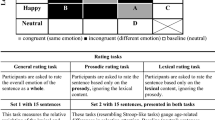Shriberg et al. [Shriberg, L. et al. (2001). Journal of Speech, Language and Hearing Research, 44, 1097–1115] described prosody–voice features of 30 high functioning speakers with autistic spectrum disorder (ASD) compared to age-matched control speakers. The present study reports additional information on the speakers with ASD, including associations among prosody–voice variables and ratings of communication social abilities. Results suggest that the inappropriate sentential stress and hypernasality previously identified in some of these speakers is related to communication/sociability ratings. These findings and associated trends are interpreted to indicate important links between prosodic performance and social and communicative competence. They suggest the need for careful assessment of inappropriate prosody and voice features in speakers with ASD, and for effective intervention programs aimed at reducing the stigmatization of individuals with these conditions.



Similar content being viewed by others
References
American Psychiatric Association (1987). Diagnostic and Statistical Manual of Mental Diseases-IIIR. Washington, DC: Author
American Psychiatric Association (1994). Diagnostic and Statistical Manual of Mental Diseases-IV. Washington, DC: Author
Arthur G., (1962). The Arthur Adaptation of the Leiter International Performance Scale. Washington, DC: Psychological Service Center
Baltaxe C., Simmons J., (1985). Prosodic development in normal and autistic children. In: Schopler E., Mesibov G., (Eds.), Communication problems in autism New York: Plenum Press. pp. 95–125
DeMyer M., Barton S., DeMyer W., Norton J., Allen J., Stelle R., (1973). Prognosis in autism: A follow-up studyJournal of Autism and Childhood Schizophrenia 3: 199–246
DeMyer M., Hingtgen J., Jackson R., (1981). Infantile autism reviewed: A decade of researchSchiophrenia Bulletin 7: 388–451
Fay W., Schuler A., (1980). Emerging language in autistic children. Baltimore: University Park Press
Kanner L., (1943) Autistic disorders of affective contactNervous Child 2: 217–250
Kanner L., (1971). Follow-up of eleven autistic children, originally reported in 1943Journal of Autism and Childhood Schizophrenia 2: 119–145
Kaufman A., Kaufman N., (1983). Kaufman Assessment Battery for Children, Circle Pines, MN: American Guidance Co
Klin A., Lang J., Cicchetti D. V., Volkmar F. R., (2000). Interrater reliability of clinical diagnosis and DSM-IV criteria for autistic disorder: Results of the DSM-IV autism field trialJournal of Autism and Developmental Disorders 30(2): 163–167
Klin A., Volkmar F., (1997). Asperger syndrome. In: Cohen D., Volkmar F., (Eds.), Handbook of autism and pervasive developmental disorders 2nd ed., New York: Wiley. pp. 94–122
Klin A., Volkmar F., Sparrow S., (1992). Autisitc social dysfunction: Some limitations of the theory of mind hypothesisJournal of Child Psychology and Psychiatry 33: 861–876
Lahiste I., (1970). Suprasegmentals. Cambridge, MA: MIT Press
Lord C., Paul R., (1997). Communication. In: Cohen D., Volkmar F., (Eds.) Handbook of Autism and Pervasive Developmental Disorders. 2nd Ed. N.Y.: Wiley pp. 195–225
Lord C., Risi S., Lambrecht L., Cook E. H., Jr., Leventhal B. L., DiLavore P. C., Pickles A., Rutter M., (2000). The Autism Diagnostic Observation Schedule—Generic: A standard measure of social and communication deficits associated with the spectrum of autismJournal of Autism and Developmental Disorders 30(3): 205–223
Lord C., Rutter M., LeCouteur A., (1994). Autism Diagnostic Interview-Revised: A revised version of a diagnostic interview for caregivers of individuals with possible pervasive developmental disordersJournal of Autism and Developmental Disorders 24: 659–685
McSweeny, J. L. & Shriberg, L. D. (1995). Segmental and suprasegmental transcription reliability (Tech. Rep. No. 2). Phonology Project, Waisman Center on Mental Retardation and Human Development, University of Wisconsin, Madison
*McSweeny, J. L. & Shriberg, L. D. (in press). Clinical research with the Prosody–Voice Screening Profile. Clinical Linguistics and Phonetics
Mesibov G., (1992). Treatment issues with high-functioning adolescents and adults with autism. In: Schopler E., Mesibov G., (Eds.), High functioning individuals with autism New York: Plenum Press pp. 143–156
Odell, K. H. & Shriberg, L. D. (in press). Prosody–voice characteristics of children and adults with apraxia of speech. Clinical Linguistics and Phonetics
Paul, R., Miles, S., Cicchetti, D., Sparrow, S., Klin, A., Volkmar, F., Coflin, M., & Booker, S. (2004). Adaptive Behavior in Autism and PDD-NOS: Micro-Analysis of Scores on the Vineland Adaptive Behavior Scales. Journal of Autism and Developmental Disorders 34(2): 223–228
Rutter M., Lockyer L., (1967). A five to fifteen year follow-up study of infantile psychosis. I: Description of sampleBritish Journal of Psychiatry 113L: 1169–1182
Shriberg L. D., (1986). PEPPER: Programs to examine phonetic and phonologic evaluation records. Hillsdale, NJ: Lawrence Erlbaum
Shriberg L. D., (1993). Four new speech and prosody–voice measures for genetics research and other studies in developmental phonological disordersJournal of Speech and Hearing Research 36: 105–140
Shriberg L. D., Aram D. M., Kwiatkowski J., (1997a). Developmental apraxia of speech: III. A subtype marked by inappropriate stressJournal of Speech, Language, and Hearing Research 40: 313–337
Shriberg L. D., Austin D., Lewis B. A., McSweeny J. L., Wilson D. L., (1997b). The Percentage of Consonants Correct (PCC) metric: Extensions and reliability dataJournal of Speech, Language, and Hearing Research 40: 708–722
Shriberg L. D., Kwiatkowski J., Rasmussen C., (1990). The Prosody–Voice Screening Profile. Tucson, AZ: Communication Skill Builders
Shriberg, L. D., Kwiatkowski, J., Rasmussen, C., Lof, G. L., & Miller, J. F. (1992). The Prosody–Voice Screening Profile (PVSP): Psychometric data and reference information for children (Tech. Rep. No. 1). Phonology Project, Waisman Center on Mental Retardation and Human Development, University of Wisconsin, Madison
Shriberg L., Paul R., McSweeney J., Klin A., Cohen D., Volkmar F., (2001). Speech and prosody characteristics of adolescents and adults with high functioning autism and Asperger syndromeJournal of Speech, Language and Hearing Research 44: 1097–1115
Shriberg L. D., Widder C. J., (1990). Speech and prosody characteristics of adults with mental retardationJournal of Speech and Hearing Research 33: 627–653
Sparrow S., Balla D., Cicchetti D., (1984). The Vineland Adapative Behavior Scales (Survey Form). Circle Pines, MN: American Guidance Service
Stephens K., Nickerson R., Rollins A., (1983). Suprasegmental and postural aspects of speech production and their effect on articulatory skills and intelligibility. In: Hochberg I, Levitt H., Osberger M., (Eds.), Speech of the hearing impaired: Research, training and personnel preparation Baltimore: University Park Press. pp. 35–51
Tager-Flusberg H., (1981). On the nature of linguistic functioning in early infantile autismJournal of Autism and Developmental Disorders 11: 45–56
Tager-Flusberg H., (1995). Dissociations in form and function in the acquisition of language in autistic children. In: Tager-Flusberg H., (Ed.) Constrains on language acquisition: Studies of atypical children. Hillsdale, NJ: Erlbaum. pp. 175–194
VanBourgondien M., Woods A., (1992). Vocational possibilities for high functioning adults with autism. In: Schopler E., Mesibov G., (Eds.), High functioning individuals with autism New York: Plenum Press. pp. 227–242
Volkmar F., Klin A., Siegel B., Szatmari P., Lord C., Campbell M., Freeman B., Cicchetti D., Rutter M., Kline W., Buitelar J., Hattab Y., Fombonne E., Fuentes J., Werry J., Stone W., Kerbeshian J., Hoshino Y., Bregman J., Loveland K., Szymanski. L., Towbin K., (1994). Field trial for autistic disorderin DSM-IVAmerican Journal of Psychiatry 151: 1361–1367
Volkmar F., Lord C., (1998). Diagnsois and definition of autism and other pervasive developmental disorders. In: Volkmar F., (Ed.). Autism and pervasive developmental disorders. Cambridge: Cambridge University Press pp. 1–31
Volkmar F., Sparrow S., Goudreau D., Cicchetti D., Paul R., Cohen D., (1987). Social deficits in autism: An operational approach using the Vineland Adaptive Behavior ScalesJournal of the American Academy of Child and Adolescent Psychiatry 26: 156–161
Wechsler D., (1991). Manual for the Wechsler Intelligence Scale for Children—Third Ed. (WISC-III). San Antonio, TX: Psychological Corporation
Acknowledgments
Our thanks to Amy Augustyn, Stephanie Miles, and Chad Allen for their assistance. Preparation of this paper was supported by Research Grant P01-03008 funded by the National Institute of Mental Health (NIMH); and by the STAART Center grant U54 MH66494 funded by the National Institute on Deafness and Other Communication Disorders (NIDCD), the National Institute of Environmental Health Sciences (NIEHS), the National Institute of Child Health and Human Development (NICHD), the National Institute of Neurological Disorders and Stroke (NINDS); a Mid-Career Development grant K24 DC006619 from the National Institute on Deafness and Other Communication Disorders (NIDCD); as well as by the National Alliance for Autism Research.
Author information
Authors and Affiliations
Corresponding author
Rights and permissions
About this article
Cite this article
Paul, R., Shriberg, L.D., McSweeny, J. et al. Brief Report: Relations between Prosodic Performance and Communication and Socialization Ratings in High Functioning Speakers with Autism Spectrum Disorders. J Autism Dev Disord 35, 861–869 (2005). https://doi.org/10.1007/s10803-005-0031-8
Published:
Issue Date:
DOI: https://doi.org/10.1007/s10803-005-0031-8




